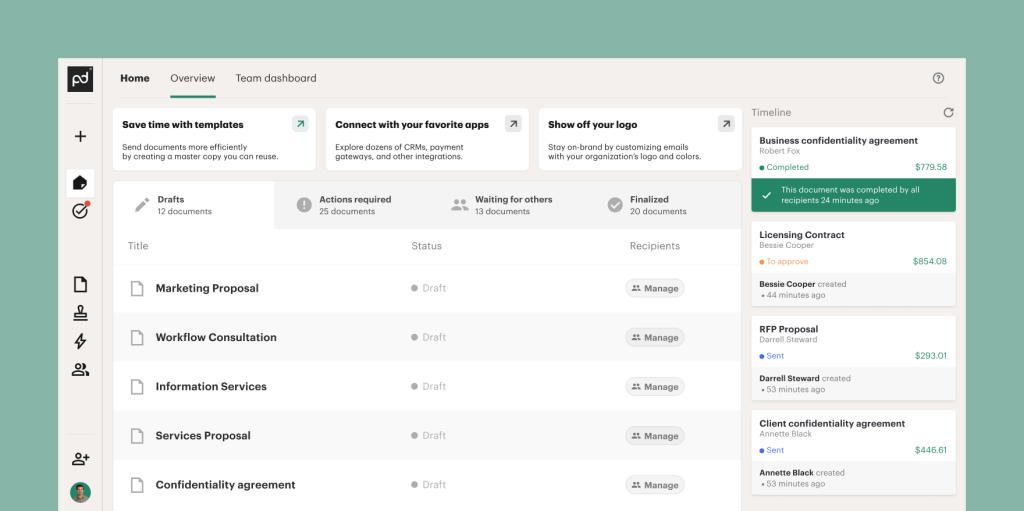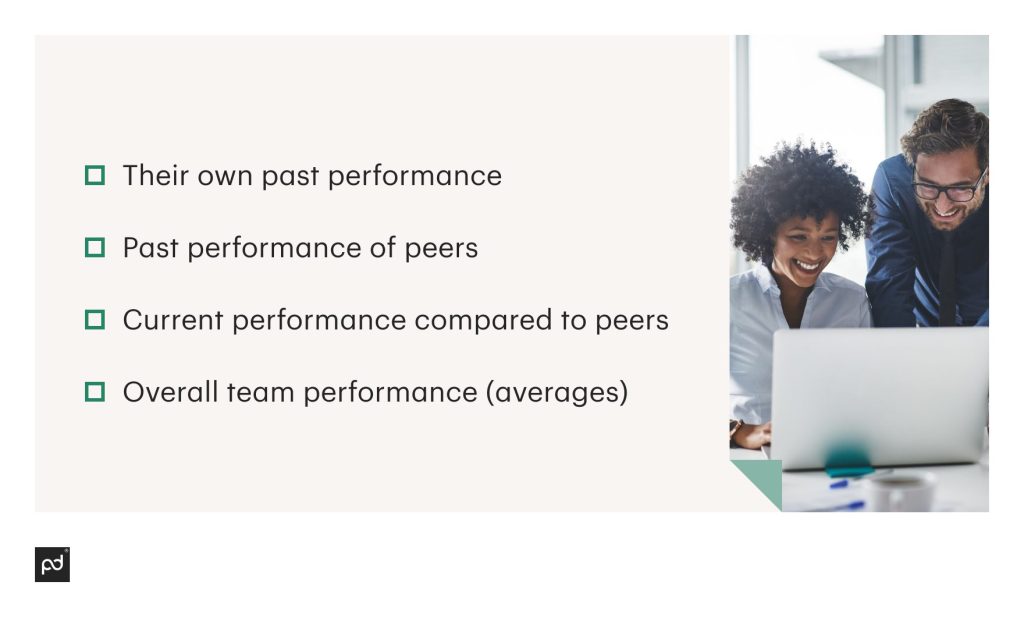Using sales quotas as a way to measure sales performance is standard fare for most organizations.
For sales reps, who are often competitive and goal-driven, achievable metrics help to streamline sales processes while providing opportunities to optimize performance and generate great results.
But finding the right sales quotas for your team is more than just mandating an ambitious number that keeps your team motivated. In fact, aggressive sales quotas can backfire and damage your company.
Here’s a quick guide to help you set sales quotas that work and a quick look at some ways that you can use software to set that up.
When sales quotas go wrong
If you’re reading this, it’s likely that you’re already familiar with how powerful sales quotas can actually be. Quotas, especially when based on realistic data, can help your sales organization thrive.
But before we get into the details of how to set the best sales quotas, let’s take a look at what can happen when quotas go wrong by reviewing a recent business example.
In late 2016, news broke that Wells Fargo & Company employees had created millions of fraudulent savings and checking accounts without a client’s knowledge or consent over the course of a four-year term.
When the employees responsible for participating in the fraud were fired, they didn’t go quietly. Instead, they amplified the public fallout and filed a $2.6bn class-action lawsuit claiming that Wells Fargo’s quotas were grossly unrealistic and that staff was demoted for not meeting goals.
Meanwhile, the employees who actively participated in the fraudulent practices during those four years were rewarded.
The company was ordered to pay $185 million for illegal activity and, by the end of 2018, agreed to a 50-state settlement for an additional $575 million.
The Wells Fargo case is an extreme example of what can happen when aggressive sales quotas and goals are set to the detriment of both employees and clients.
But the stress and psychological effects of imposing quotas on your employees can also damage your business without fraud ever being part of the equation. Finding realistic goals that still keep your SDRs performing is difficult but, when done right, it will motivate your sales team.
Step 1. Review your historical data
Setting realistic and successful sales goals starts with studying your data and evaluating your baseline. Pull up sales reports from previous quarters, and review year-over-year reports.
Consider the following questions:

As you parse your historical data, it’s important to consider all factors that might have impacted your sales results.
For example, if your supply chain encountered issues and your flagship product was out of stock for two months, that may have had an impact on your results for that period of time.
Likewise, if the company launched a new product or had success with a new market opportunity, any sales forecasts or projections might have been low for a given period, resulting in easy-to-achieve sales quotas.
In PandaDoc, you can find most of this information in the dashboard:

By clicking on any of the colored tiles, you can see what deals have been closed over a given period, which deals closed most often, and much more.
You can even filter those results by team members to get a better idea of who has been successful and what documents they use most often.
Your past sales data can give you great insights into team performance and how to adjust your sales targets, but take the time to understand the full story – not just the results — before you start adjusting your quotas and metrics.
Over-the-top goals that no one can meet month after month are ineffective and can drive your sales team to seek other opportunities, especially if rewards and incentives are tied to the performance quotas that you set.
On the other hand, setting goals that are too low isn’t much of a motivator and won’t inspire top performers.
Once you have an accurate understanding of your data, check to see the average number of sales per month and which sales reps typically hit those goals.
You should be able to do this by pulling data over a year-long period and reviewing historical performance for your team as a whole and for individual salespeople.
Based on your data, who met the quotas and who didn’t? Was it only the top performers in your company or a mix of sales representatives?
As you start to make changes, keep those factors in mind. Only focusing on superstar salespeople will ultimately demotivate team members who feel they can never compete.
Meanwhile, lowering the bar to meet the worst-performing sales rep isn’t healthy for your staff, either.
Step 2. Use caution when setting the base quota
Once you have all of the historical data, you can set your team up for success by creating a realistic sales baseline. However, this might be trickier than it sounds.
Some sales managers decide to set the quota based on the highest-ever month of sales, regardless of context. As we covered in the previous section, taking this approach can skew your goals so dramatically that they’re only attainable by your best performance under perfect conditions.
A common example of creating this kind of negative feedback loop can happen when a rep manages to close a few new clients at the same time they receive a surprise referral or when a large number of old clients renew their accounts.
This creates a sales spike that your reps can’t realistically duplicate every month because the conditions are outside of their control.
If your sales software is sophisticated enough, you may be able to analyze sales activities or split conversion types to better understand rep account acquisition.
Unfortunately, if you don’t have insight into conversion rates and how closed deals moved through your sales pipeline, it might be impossible to spot those outliers.
Taking another look at the PandaDoc dashboard or the PandaDoc reporting tools can give you some great insights into how often documents convert and where those deals fall out of your pipeline.
These tools can help you figure out a baseline quote that makes sense based on volume and close rate.
However, raising the quota every time a sales representative has their best month ever is also detrimental to employee morale.
The operating philosophy that often leads to this trap is the drive to do more or do better every single month. But, as every company learns — often the hard way — perpetual growth is never sustainable.
And your reps know it, too.
Setting a baseline at the employee’s best month will simply deter your reps from pushing themselves every month, especially if that best month was an outlier in their metrics.
Instead, they’ll settle on a number that feels realistic to them, and you’ll lose a key motivational performance tool.
Especially if your metric of success is defined by the previous month’s performance, your reps may choose to purposefully underperform after strong months to ensure that they won’t fail during the following months.
Oftentimes, setting flexible baselines like this can be seen as moving the proverbial goalpost.
If a rep does well, success becomes that much harder in the following months, so it’s a no-win situation that can lead to burnout for even the best performers.
Rather than taking this approach, set a minimum number of sales you will accept as a manager and let your team know what minimum expectations to work from.
You can also let them know that you expect them to exceed these expectations. From there, you can create a culture of motivation around your mission by holding meetings and reminding your team that you expect them to outperform those basic goals each and every month.
Keep in mind that getting everyone on board may not be so simple if you’re setting new goals and expectations with an existing team.
You won’t want to align your expectations with the lowest performer which means that, by default, some of your reps will start below the minimum threshold. When you implement this change, be sure to have a plan ready to help underperformers rise to meet those minimum standards.
Step 3. Consider teams and individual quotas
Now that you’ve set a minimum benchmark for performance, take a minute to consider the dynamics of your team and how your organization measures success.
In most companies, sales reps are measured against multiple performance metrics including:

Armed with data from a wide range of metrics and sales history, work out both sales and secondary goals as a team.
Give your team a chance to strengthen their performance and take ownership of their role by setting individual sales goals that align with their strengths and focus areas.
If you have an activity quota or a revenue goal in mind that exceeds your minimum baseline, distributing these expectations on an individual level can help you continue to push your reps toward success.
These smaller (still achievable!) goals are great for training and sales development.
You can even track many of these goals with PandaDoc activity reporting.
In the reporting window, you can check the number of documents sent, the frequency that each document is used, and figure out what your top performers are doing differently to achieve success.
Use this information to give your team a chance to further expand their skills and knowledge by working together.
If one rep is great at building qualified leads but terrible at closing, pair them up with a performer who does a great job closing deals and see what they can learn from one another.
But keep in mind that company goal setting isn’t just about improving employee morale and teamwork. Your sales reps will likely have additional insights on what’s realistic and what truly motivates them.
They may have incredible ideas on how different sales seasons impact their success and how to incentivize the entire team.
Something else can happen when your team is involved in sales quota decision-making goals: your team members will hold themselves accountable when they’re actively involved in the process.
As a result of this bottom-up approach, quota attainment becomes viable on an individual level. Your team no longer has the opportunity to complain about the team’s quota since they were part of the process that created those goals.
As always, this requires a balance. Many organizations take a top-down approach to sales, where sales forecasts and numbers are delivered from top-level executives who expect results.
The minimums you set for your sales force will likely need to reflect those goals.
Step 4. Add incentives to create results
Beyond your baseline and any individualized or team sales goals, you may find success when using additional incentives to motivate teams to continually strive for high performance through various stages of your sales cycle.
We’ll cover a few incentive opportunities for sales teams below, and you may be able to find additional incentive opportunities within your organization.
Sales compensation plans and commissions
A simple commission-only sales structure could help propel your team forward to earn the amount of money they want.
However, setting caps on commissions can bring their performance and productivity to a screeching halt. There’s little reason for reps to keep working and performing at their highest level without the incentive to continue earning that commission.
It’s also possible that removing commission caps altogether can improve your bottom line and increase your sales team’s motivation to perform. There are even studies to back this up.
Research published in the Harvard Business Journal found that removing sales commission caps (or setting them as high as possible) increases sales and overall financial health for the company.

The research also shows that simplifying the commission structure and maintaining transparency are key motivators.
Make sure your sales team understands exactly how their commission structure works and how many sales they’ll need to meet goals for both the company and themselves.
Personalized incentives
Money and bonuses aren’t the only motivators for sales teams.
In fact, big bonuses attached to every success could backfire and demotivate your team. They may decide there’s no way they can hit that goal so they won’t try as hard.
Or they may only work as hard as possible when the bonus is attractive enough.
One tried and true strategy to combat these issues is to simply ask salespeople what kind of incentives they want.
This can help you motivate your team without setting unrealistic expectations for success. Set expectations on a reward budget, as well as what the objective and timeframe should be to earn that reward.
That way everyone is involved in the process, and the pressure is set appropriately. You could also consider offering low or no-cost rewards such as an extra day off or comp time for their hard work.
Recognition and perks
Psychological rewards can be powerful motivators in their own right. Reps may also need an injection of intrinsic motivation to keep their level of performance high.
Your sales team can find their internal drive when you publicly praise their performance and give credit where it’s due.
Other ideas can be as cost-effective as they are impactful.
Consider rewards like lunch with the boss to get in more face time or an extra day off. The choice of a new client or territory can also boost motivation for top performers eager to get ahead.
This type of motivation can also be extremely useful if you’ve set extra quotas and performance metrics around necessary but lower-value contributions to the team, especially if you’re planning to use compensation and bonuses as the primary motivator.
When a rep takes the time to clean up the CRM, follow up on a post-sale call, cover a demo session, build a template, or complete other minor tasks that contribute to team performance, it’s still important to recognize them for their hard work.
In fact, acknowledging team contributions like this may ultimately be more important to team cohesion, since everyone can do them.
At the end of the day, you’re likely to have one or two top performers really driving the team toward the revenue quota.
Acknowledging other ways that people contribute, even when they aren’t driving revenue, can be a way to give mid- and low-level performers their opportunity in the spotlight.
Advancement opportunities
One of the biggest challenges when it comes to sales is advancement.
Ideally, great performers can move into leadership roles where they can teach others to replicate their success.
But becoming a strong leader takes time away from the phones and away from potential earnings if you’re using sales-based commissions and payouts.
Make it worth a rep’s while to put the phone down for a few hours.
Assign senior sales leaders and personnel to mentor junior members of the team can be a huge motivator for both sides of the equation.
Mentoring each other through the process can help to foster a sense of job ownership and pride while helping team members with less experience develop in their careers more quickly.
Senior staff members can also learn something from younger staff, like leveraging social media or new technology tools to generate more leads and close more sales.
Step 5. Building your team with strong quotas
Once you implement effective, realistic sales quotas, make a conscious effort to step back from reprimands, lectures, or badgering about performance.
There’s no reason to beat down or punish your sales teams when you can simply let them do it themselves. Relying on a commission-focused model means those representatives won’t get paid without making sales.
You may discover that the salesperson who couldn’t seem to manage even a few sales calls and meetings suddenly leaps into action when their income is on the line.
Employee morale plummets when reps are subjected to ongoing lectures and tense meetings on why they’re not performing. Your employee retention rate is also on the line when it comes to office negativity.
Beating down your sales teams with reprimands, creating unrealistic commission structures and bonuses, and calling them out in public for underperforming will ultimately just drive them to quit.
And the costs of recruiting, hiring, and training new team members can drag down your profits.
Final thoughts
There are all types of sales quotas out there. SDRs might have volume quotas, revenue quotas, demo quotas, or a combination quota that measures a variety of metrics all at once.
It’s fair to say that if there is a metric about it, a company somewhere had tried to set a quota to see if meeting a requirement has a noticeable effect on performance.
However you choose to set your quotas, the most important thing to remember is that your reps are still people at the end of the day. Metrics and quotas are powerful motivational tools, but sales reps will need more than that to find success.
Keep that human element in mind when setting your sales goals because, when hitting the numbers becomes more important than anything else, it’s easy for teams to lose focus on the larger picture.
Originally published October 2, 2018, updated November 30, 2021


